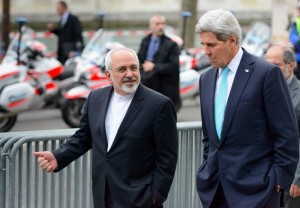Nuclear deal boils down to trust, not just verification
In the real world, a deal is rarely possible without at least a modicum of trust between the parties, but the paradox of Tuesday’s agreement on Iran’s nuclear programme with six world powers is that no one, least of all the US president, will say that trust was a factor at all.
“This deal is not built on trust – it is built on verification,” Barack Obama emphasised in a televised address soon after exhausted negotiators emerged blinking into the bright Viennese sunshine from 18 days of close-focus haggling at the sumptuous Palais Coburg hotel.
The US president has his reasons for disclaiming trust as a determinant in this, one of the most game-changing deals in recent times for this region and the wider world. But here’s a question: how likely was the agreement without the ties (perhaps even quasi-residual trust) shared by two of the principals in the negotiating arena, US secretary of state John Kerry and Iran’s foreign minister Mohammad Javed Zarif?
How likely was the agreement, a tortuous work in progress for 12 years, if Mr Kerry did not have an Iranian-American son-in-law and a sister who had lived and worked in Iran, spoke the language and expressed great affection for the Iranian people?
How much less probable would the deal have been had Mr Zarif not spent 20 years in the US, had two children while in that country and a long-lived association with US senators Joe Biden, Chuck Hagel and Dianne Feinstein, among others? The first is the current US vice president. The second was, until recently, US defence secretary. The third chairs the Senate select committee on Intelligence and at 82, is also, incidentally, America’s oldest currently serving senator.
There is a worthwhile point in recalling these two men’s tangential links, going back years, to each other’s country. Deny as one might, there must have been some basis of personal belief in each other’s word, as Mr Kerry and Mr Zarif faced each other across the table in that Viennese hotel.
This should be reassuring in some ways because the actual deal does not seem to be, at least right now. That’s because of the verification aspect. This is the issue that will sway many members across the political divide of the US Congress, which has to buy the deal to allow the US to lift all of its sanctions against Iran.
Many Congressmen, even those who belong to Mr Obama’s Democratic Party, admit that they are torn between a desire to support their leader and a very real concern about signing up to something that might let Iran proactively cheat on its nuclear activities, with only retroactive consequences. Rightly so.
Much of the world, not just the Middle East, will be worried about verification of Iran’s intentions. It has form, as they say, in this respect. Four decades after it signed a deal to set up more than 20 civilian nuclear power plants, Iran still has only one, Bushehr, on its southern coast. And for all Iran’s adamant proclamations about its desperate need for nuclear energy, Bushehr doesn’t even use the thousands of centrifuges that it operates at Natanz or Fordo. Russia provides all the enriched uranium and takes away all the spent fuel. So, what’s the purpose of the Natanz and Fordo nuclear fuel enrichment capabilities?
The possibilities start to seem even more sinister when one remembers that Fordo’s existence was only disclosed by Iran to the International Atomic Energy Agency six years ago when they had no option because western intelligence agencies already knew of it. Will the new deal provide guarantees that there will be no nasty surprises?
Probably not. You don’t have to be a nuclear inspector to realise that. The verification regime laid out in the deal does not allow inspectors no-notice, “anywhere, any time” scrutiny of all declared and suspected Iranian nuclear facilities, including military installations.
Instead, it permits something that’s described as managed access. This means that Iran will only allow IAEA inspectors to visit where they want after they have provided reasons for concern about suspected prohibited activities there. The Iranians will have the opportunity to address these concerns and then must allow access within two weeks. If they don’t, and the question marks persist for yet another week, the situation would be deemed a violation of the agreement and subject to reimposition of sanctions.
Then there is the issue of other allegations that Iran has not met its obligations. A joint commission set up by the agreement will seek to resolve the dispute within 30 days. If that fails, the allegations and the commission’s view would be referred to the UN Security Council, which would have to vote to continue sanctions relief. A veto by a permanent member would mean that sanctions would be reimposed. The whole process has to be complete within 65 days.
Both the paths described above are convoluted and it is not only the paranoid who might wonder if the Iranians view them with some mendacity. The provisions of the deal could technically allow them to have their way, secure in the knowledge that there is a window – ranging from three weeks to 65 days – before the UN Security Council could impose sanctions again. Might they use the time to do as they will and hide or disperse evidence of any prohibited activity, all the while playing footsie with nuclear inspectors and reaping the benefits of free access to the world economy?
It really does boil down to trust, not just verification. The P5+1 – and the world – has to believe that Iran is capable of and desirous of trust. Or to paraphrase Henry Kissinger, that Iran has finally made up its mind about whether it wants to be a country or a cause. A trustworthy country rather than a corrosive cause.


